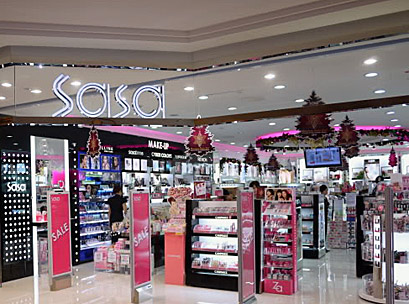Beauty chain SaSa’s sales rose in the first half year – but the Occupy Central protest has dented Hong Kong trading since the books were closed.
In the six months to September 30, Sa Sa International, parent of the SaSa network of cosmetics stores in Hong Kong, China, Macau, Singapore, Taiwan and Malaysia, increased sales 8.4 per cent, year-on-year to HK$4.226 million. Retail sales in Hong Kong and Macau soared 10.2 per cent.
But the group’s gross profit margin slid from 47.0 per cent to 44.6 per cent and profit by 4.9 per cent to $339.8 million.
Sa Sa has warned that slowing tourist arrivals from the Chinese mainland and the Occupy Central protests, which closed streets in both Kowloon and Hong Kong, have impacted on sales in October and November.
In the third quarter, up to November 16, retail sales growth in Hong Kong and Macau has slowed to 0.4 per cent year-on-year, down from 18.9 per cent last year, while same store sales fell 2.4 per cent year-on-year, compared to a rise of 15.8 per cent the previous year.
Sa Sa says there is increasing competition from other countries in Asia to attract mainland Chinese tourists and the more affluent travelers from tier-1 and tier-2 cities are increasingly choosing destinations other than Hong Kong.
Moreover, there was a 6.7 per cent decrease in the average ticket size of mainland customers, attributable to the faster growth of tourists originating from lower tier cities in China with less spending power as well as the increasing demand for lower price point products (for example, Korean products) and the central government’s anti-corruption drive.
“In addition, tourist arrivals’ growth in face of political instability in Hong Kong may be affected by the central government or individual consumer decisions,” the company said in a statement.
“However, the group remains cautiously optimistic about the longer term growth outlook of Hong Kong retail sales because more and more mainland China residents will have higher disposable income, especially those from lower tier cities. Moreover, the integration of Hong Kong into Mainland China will be enhanced by shortened travel times on improved transportation links, such as the high-speed rail link and the Hong Kong-Zhuhai-Macau bridge.”
Sa Sa is closing some stores in tourist districts where new leases were signed up during a stronger retail environment in anticipation of losing old leases that were about to expire. Due to slower growth in the areas that rely on overnight Mainland China tourists than in residential areas, the Group is not renewing the old leases.
In addition, same day visitor arrivals have grown at a faster rate than overnight ones while these visitors tend to spend less per transaction. This has contributed to a lower ticket size for Mainland customers.
During the six months, Sa Sa’s Hong Kong network reduced by a net one store, leaving 97 in Hong Kong and eight in Macau, plus one Suisse Programme specialty store and two La Colline specialty stores.
Mainland moves
Overall turnover for the Group’s mainland China operations decreased by 0.9 per cent in local currency terms to $166 million, while same store sales in local currency decreased 3.5 per cent for the period. The group continued to roll out its boutique stores in the first half of the year, which resulted in relatively steady profitability and contributions.
However, due to a change of importer and logistics issues, overall performance was affected by out-of-stocks on own-label products.
During the period, the group opened more stores in Southern China where Sa Sa says it has stronger brand awareness and better support from landlords. As at September 30, the group had a presence in 32 cities across 16 provinces in Mainland China with 61 Sasa stores and three Suisse Programme counters in five regional clusters.
Turnover in Singapore, where Sa Sa has 22 stores, was HK$123.3 million, down 1.2 per cent in local currency terms over the previous period.
Sa Sa says same store sales fell seven per cent due to “a substantial increase in overall retail space over the last two years” resulting in “a significant dilution of sales” in existing stores.
Another challenge was filling vacancies for frontline staff as well as manpower constraints due to tightened foreign worker quotas.
“High vacancy rates and high staff turnover adversely affected the group’s store productivity.” Turnover in Malaysia, where Sa Sa has 55 stores, was HK$168.4 million, up 4.4 per cent in local currency terms. Same store sales decreased 0.4 per cent in local currency.
In Taiwan, sales increased by 8.2 per cent in local currency terms to HK$139.1 million, and same store sales rose 4.1 per cent.
“Despite local consumption sentiment remaining weak, the group’s sales was strategically boosted by the enhanced House Brand product mix and lower priced product offerings, which were aimed at increasing traffic and driving sales through cross-selling.Sa Sa has 30 stores in Taiwan.
Sasa.com sales reached HK$195.9 million, up 5.5 per cent over the previous period. As a result of the shift of the group’s focus in the China market last year, sales from mainland China continued to register a faster growth. However, this performance was partly offset by a decrease in sales to other markets such as Australia and the United States. Sales in the Mainland China market were boosted by flash sales and linked sales; enhanced marketing capability and channel advertisement optimisation (social buys plus word of mouth); and localised payment gateways.
Outlook
Sa Sa said the coming year will undoubtedly be challenging because of the growth of political unrest in Hong Kong, a relatively weak global economy and pricing competition adding pressure in a slower market.
“In response to the pressures, the group’s long-term goal is to increase contribution from markets outside Hong Kong and from e-commerce. The group will make further efforts to strengthen its own labels, support its brands with storyline and marketing investments, and improve the strength of its product offerings. In addition, the group will identify consumers’ preferences for new products as well as their ever-changing requirements in regard to product functions, so as to offer appropriate products to satisfy these demands.”







